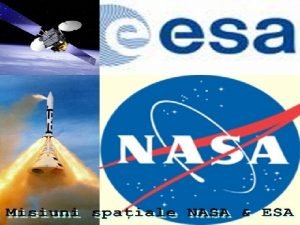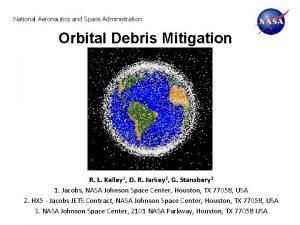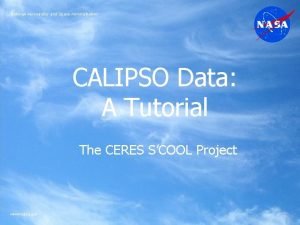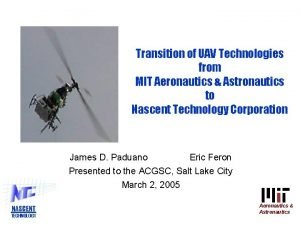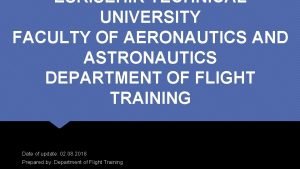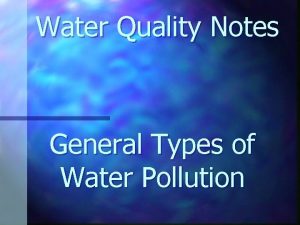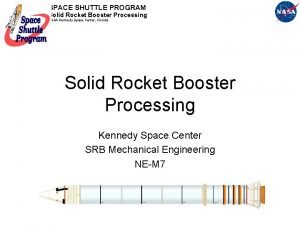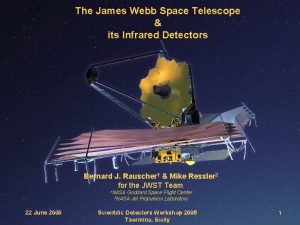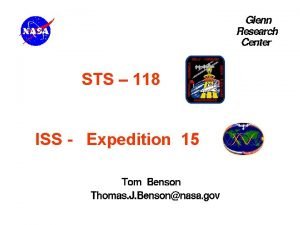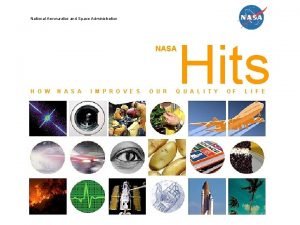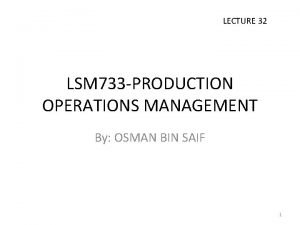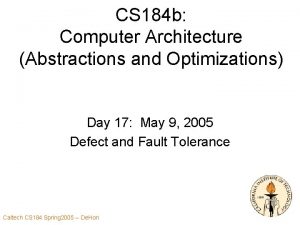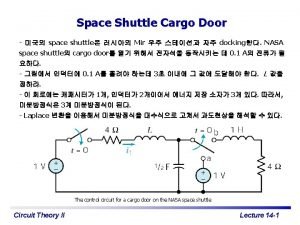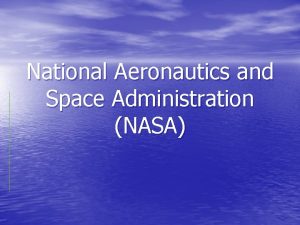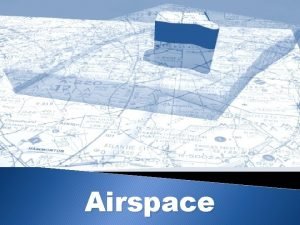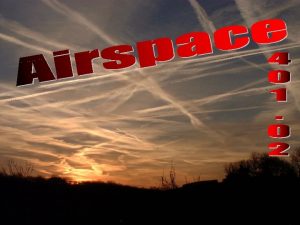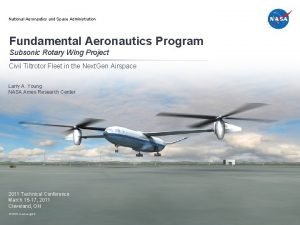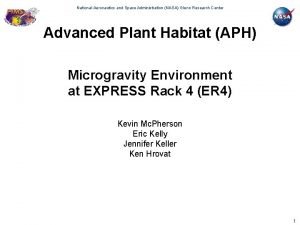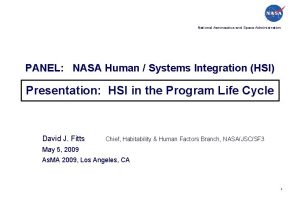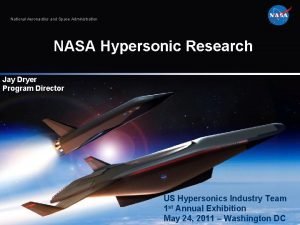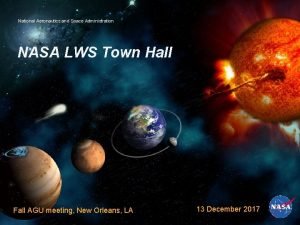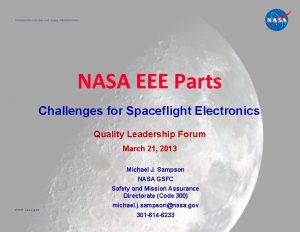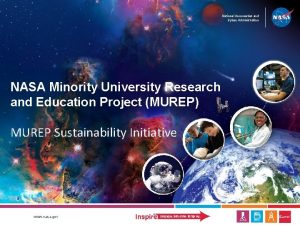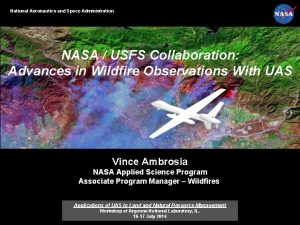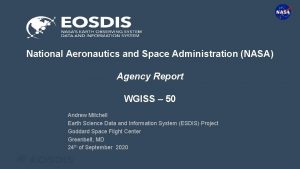National Aeronautics and Space Administration NASA Aeronautics Airspace

















- Slides: 17

National Aeronautics and Space Administration NASA Aeronautics Airspace Systems Program Air Traffic Management Research for the National Airspace System Briefing to the IT Summit John A. Cavolowsky Director Airspace Systems Program Aeronautics Research Mission Directorate August, 2010 www. nasa. gov 1

Background Demand for aviation is expected to increase, creating the need for a system that: • Provides two or three times capacity together with increased safety, security, efficiency and environmental capacity • Accommodates a range of vehicles including very large aircraft, very light jets, unmanned aircraft systems and space launches 2


National Airspace System (NAS) On average, about 50, 000 flights use NAS services each day 14, 500 air traffic controllers 4, 500 aviation safety inspectors, and 5, 800 technicians to operate and maintain services More than 19, 000 airports and 600 air traffic control facilities. In all, there are 41, 000 NAS operational facilities • Over 71, 000 pieces of equipment, ranging from radar systems to communication relay stations • • • NAS is a highly complex system

Air Transportation in 2010 Since its inception, we have seen many improvements in the aviation system • Air traffic control procedures using radar separation and clearancebased operations for individual flights • Avionics including radios, flight management systems, traffic collision avoidance systems, data-links, etc. • Aircraft performance Today’s system is constrained • Capacity is limited by controller workload • Demand is managed to meet available capacity • Uncertainties in weather and flight trajectories are handled by personnel using operational judgment • And more 5

Participants and Needs • Operators – – – Schedule integrity under all weather conditions Fuel efficient operations Reduced costs Predictability Access Preferred routes Pilots • Service Providers – Increased human-system productivity – Better and up-to-date information • National and community needs – Safety – Minimized environmental impact – Designed to accommodate future demand • Passengers Dispatchers – On time arrival and departure – Affordability and availability – Reliability and safety Multiple needs of air transportation system Flow Managers

State-of-the-Art • Current air traffic management system is based on highly manual operations with limited support from decision support tools and automation • Role of air traffic management is to maintain safe, expeditious, and efficient flow of traffic – Strategic decisions (2 -6 hours in advance, Command Center and Facility Traffic Management Unit) • Establish strategies for NAS and facility flow in and out of all airports and airspace in presence of weather and demand/capacity imbalance – Operations in airspace (En route and oceanic, rest of airspace) • Safely separate aircraft from each other and avoid severe weather • Provide most efficient operations – Operations near airport (Terminal, 30 -50 miles from airport) • Separate aircraft and balance arrival/departure flows • Provide efficient routings for arrivals, departures, and overflights – Operations at each airport (Tower, 2 -5 miles from airport and on surface) • Provide for safe and efficient movement of aircraft on taxiways and runways, and arrivals/departures near airport • Set runway configuration (arrival/departure allocation) • Current system is not well integrated nor scalable

Issues and Challenges Ahead • New types of vehicles and more unscheduled flights • Allocation of automation between cockpit and ground • Allocation of functions between automation and human operators • Graceful degradation of highly automated systems under offnominal conditions • Insufficient information sharing between decision-makers • Leading to uncoordinated decision-making • Modeling failure and uncertainty • Dealing with weather uncertainty • Decision-making using probabilistic information • Development of fault tolerant systems integration for safety • Testing of new concepts in today’s operations Naming just a few… How will the nation address these challenges?

Achieving Future Air Transportation Capability • The Next Generation Air Transportation System vision requires a shift to trajectory-based operations using 4 D trajectories, reduced separation in dense traffic, dynamic resource allocation to meet demand, and more • Significant research challenges must be met to mitigate airportal and airspace constraints to address the demand/capacity imbalance problem in a safe, equitable, and efficient manner NASA transitions advanced technologies and operational capabilities to implementing entities. NASA has no operational responsibilities or authority. 9

November 18, 2008 Presentation at Jefferson Labs This slide has been taken in its entirety from a publicly available JPDO presentation. 10

Next. Gen Transformation From… To… Ground-based Navigation and Surveillance Satellite-based Navigation and Surveillance Voice Radio Control Digital Data Exchange Disconnected Information Systems Net-Centric Information Access Human-centric Air Traffic Control Automation Assisted Air Traffic Management Fragmented Weather Forecasting Probabilistic Weather Decision Tools Visibility Limited Airfield Parameters Equivalent Visual Operations Forensic Safety System Prognostic Safety System Inefficient security screening Integrated Security Risk Management Current aircraft environmental footprint Much reduced aircraft environmental footprint 4

NASA Aeronautics Research Mission Directorate Fundamental Aeronautics Program Integrated Systems Research Program Conduct research at an integrated Conduct cutting-edge research that will system-level on promising concepts and produce innovative concepts, tools, and technologies and explore/assess/demonstrate technologies to enable revolutionary the benefits in a relevant environment changes for vehicles that fly in all speed regimes. Airspace Systems Program Directly address the fundamental ATM research needs for Next. Gen by developing revolutionary concepts, capabilities, and technologies that will enable significant increases in the capacity, efficiency and flexibility of the NAS. Aviation Safety Program Conduct cutting-edge research that will produce innovative concepts, tools, and technologies to improve the intrinsic safety attributes of current and future aircraft. SVS HUD Aeronautics Test Program Preserve and promote the testing capabilities of one of the United States’ largest, most versatile and comprehensive set of flight and ground-based research facilities. 12

The Airspace System Program Develop, demonstrate, and transition future integrated concepts, capabilities, and technologies that will enable air traffic service providers to provide major increases in air traffic management effectiveness, flexibility, and efficiency, while maintaining safety to meet capacity and mobility targets consistent with the Next. Gen vision • Concept and Technology Development Project: Develop gate-to-gate concepts and technologies towards Next. Gen to enable significant increases in capacity and efficiency • Systems Analysis, Integration, Evaluation Project: Facilitates the R&D maturation of integrated concepts through evaluation in relevant environments, provides integrated solutions, and characterizes airspace system problem spaces, defines innovative approaches, and assesses potential system impacts and design ramifications of the program’s portfolio. 13

The Aeronautics Enterprise “As the science and application of aeronautics progressed, an interdependence developed among the aircraft, the air transportation system, and the people who use these systems, resulting in a multi-dimensional, highly integrated aeronautics enterprise…. Treating the entire system as a whole is complex but necessary, and requires close coordination among multiple government departments and agencies as well as industry, academia, and other non-Federal stakeholders to ensure that the needs of all enterprise users are addressed. ” - National Aeronautics R&D Policy 14

Systems Requirements for Next. Gen R&D • • Multi-Disciplinary Analysis and Optimization Human-Automation Integration Decision Making in Uncertainty V&V and Certification of Complex, Adaptive, and Non-Deterministic Systems 15

Enabling Next. Gen 16

17
 National aeronautics and space administration
National aeronautics and space administration National aeronautics and space administration, u.s.a.
National aeronautics and space administration, u.s.a. Lasenggo kahulugan
Lasenggo kahulugan Calipso data download
Calipso data download Mit aeronautics and astronautics
Mit aeronautics and astronautics Department of aeronautics and astronautics
Department of aeronautics and astronautics Nasa space shuttle
Nasa space shuttle Shuttle srb
Shuttle srb James nasa says space launch its
James nasa says space launch its Nasa space shuttle
Nasa space shuttle Nasa space shuttle
Nasa space shuttle Nasa space shuttle
Nasa space shuttle Nasa space shuttle
Nasa space shuttle Nasa space shuttle
Nasa space shuttle James webb nasa space telescope launch
James webb nasa space telescope launch Nasa space shuttle
Nasa space shuttle Nasa space shuttle
Nasa space shuttle Impulse function
Impulse function
